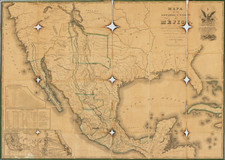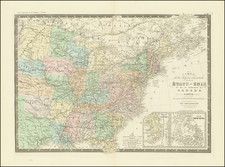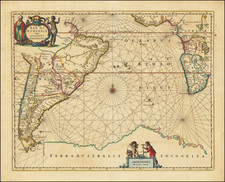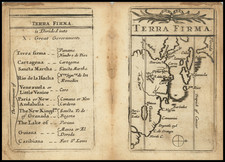Manuscript Sea Chart of The Gulf Stream and The Atlantic Demonstrating an Intimate Sailing Knowledge
A remarkable manuscript map of the Atlantic Ocean, which likely illustrated an early American manuscript journal. The author marked sites of personal and historical importance, giving the modern viewer a rare window into an early-nineteenth century mind.
The chart reflects a detailed knowledge of the East Coast of North America, the Caribbean, Central America and Bermuda, with other pockets of attention along the West Coast of Africa and the coast lines of northern Spain and France. The Gulf Stream is prominently illustrated, drawn from the works by Benjamin Franklin and the works published by the American Philosophical Society in the 1790s. While not intended as a navigational tool, as noted below, the creator's primary interest and focus applies to the major routes of commerce and trading places in North America, the Caribbean and West Africa.
The chart was most recently acquired from a private collection in the Philadelphia area and was almost certainly done in the first part of the nineteenth century by an American, based upon the details shown, spellings, historical information set forth in the chart and the scope of coverage. We date the map to circa 1810, based upon the inclusion of the Chatham Lighthouse, which was completed in 1808.
Pownall and The Atlantic Ocean
The most likely base map for the manuscript is The Atlantic Ocean, by Governor Pownall, first published first by Robert Sayer circa 1787. Pownall served as lieutenant governor of New Jersey from 1775 to 1757, and as governor of the Massachusetts Bay colony from 1757 to 1760. Prior to those appointments he traveled North America for two years. The chart of the Atlantic was not his first cartographic work. In 1755, Pownall contributed to a corrected version of Lewis Evans' famous map of North America.
Pownall's chart and this manuscript map show roughly the same area, although the manuscript chart focuses most closely on the East Coast of North America, cutting out the British Isles, Northern Europe and the Canadian Arctic . Many of the place names and the location of these names indicate that the Pownall chart served as a base for this manuscript. For example, the location and shape (angle, curved, etc.) of most of the major place names are similar, particularly "South North Carolina", "Caribee Islands", and "Bahama or Lucayos". Some place names have spellings that suggest error ("Carved Rock" instead of "Carvel Rock" in the Azores) or idiosyncrasy on the part of the manuscript author ("Louisianah", "Great Bank" instead of "Grand Bank"). The doubling of certain place names, such as Philadelphia and New York, suggest that the map was drawn with a few toponyms to start and more were added over time. The squeezed look of some of the place names also supports this.
There are no rhumb lines or sounding depths, indicating that this map was never meant for navigation, although there are wind arrows. There is also the Gulf Stream, which was of interest to those with scientific leanings in the late eighteenth century, like Thomas Pownall. First illustrated by Benjamin Franklin in his Chart of the Gulf Stream published in Paris in 1782, the topic of the Gulf Stream was then a major topic of discussion, with a number of articles published in Philadelphia in the 1790s by the American Philosophical Society and other describing the Gulf Stream.
As noted below, while the Pownall map likely served as the base, the present manuscript map is vastly more detailed and includes clues of ownership that tell a fascinating story.
Innovations and additions by an engaged reader
There are many instances of divergence from the Pownall map, however. An area with a cluster of the most divergent naming is the northeastern coast of North America. There, the new place name of most note is Washington (D.C.); the capital which was on neither the 1787 nor the 1794 editions of Pownall. Also of interest, although the author lists many names that would suggest they know the Eastern Seaboard well, they erroneously switch the placement of Boston and Providence.
The Caribbean also has far more place names than Pownall's work, indicating the author's familiarity with the region. The Mosquito Coast, named for the Tawahara Miskitu people in what is now Honduras, has highly specific place names, including settlements started by Dutch pirates (Bluefields) and those with a specific resource in mind (Guana Reefs).
Bermuda is prominently labeled on the map, unlike in the Pownall map. The two toponyms included are Wreck Hill and Georges Town. On August 14, 1775, Bermudian rebels stole gunpowder from the stores at St. George's Town and sent it to aid Washington and the Continental Army. After this Bermudian Gunpowder Plot and other instances of illegal trade, the HMS Nautilus and the Galatea were stationed in Bermuda in 1776. British soldiers were stationed at the dilapidated yet strategically located fort at Wreck Hill. In 1777, two American warships took the fort, spiked its guns, but then retreated when the British soldiers returned with reinforcements. After these embarrassing incidents, the British Admiralty decided to refortify Bermuda as a major naval base.
Lighthouses
Another insightful place name is the Cardouan Lighthouse, near Bordeaux. A lighthouse has existed in some form at that location since the fourteenth century; it is France's oldest. However, in the 1780s, new works commenced that made the light one of the tallest in the world. It was one of the first to use a turning light dish. It would have been a site of note for sailors and engineers.
Other lighthouses also grace the coastlines. "Chatham Light", on Cape Cod, was established in 1808 as a light station. Chatham was only the second lighthouse erected on Cape Cod and is still an active station today. Further south, the Cape Henry Lighthouse in Virginia is also labeled on the manuscript map. Established in 1792, the Cape Henry Light was the first lighthouse authorized by the US government.
All of these details allow for some conclusions. The paleography suggests a creation date of the late eighteenth or early nineteenth century. Thanks to the inclusion of the Chatham Lighthouse, we know the manuscript map was still being worked on in 1808, when the light was built. The inclusion of lighthouses and the mention of the Bermuda-American connection, and the note of the best latitude to run to Bermuda, suggest that the author is a maritime man, perhaps a merchant or educated man with some sailing experience. This maritime aspect is heightened by another note, citing extreme shoals, near Cape Hatteras. The other more narrative note is the location of Columbus' landing place in 1492. Finally, the inclusion of Washington, the profusion of local American place names, and the highlighting of American victories in Bermuda suggest that author was American.
These notes, along with the place names that were culturally relevant in the later eighteenth century and early nineteenth century, suggest that this was a commonplace map, i.e. a personal reference material intended for self-improvement and aggrandizement. This was likely drawn by an American person (likely a man) well-read in current events, natural history (science), and geography. It was most likely a template used to illustrate a personal journal that helped this author to make sense of a rapidly changing world.
However, many mysteries remain. For example, what is the Isle of Holt near Nantucket? And to what does the Chief Channel off the coast of Guatemala refer? More discoveries await in this manuscript map.
Hugh T. Harrington, “The Bermuda Powder Raids of 1775,” Journal of the American Revolution (2014), https://allthingsliberty.com/2014/11/the-bermuda-powder-raids-of-1775/
Michael J. Jarvis, In the Eye of All Trade: Bermuda, Bermudians, and the Maritime Atlantic World, 1680-1783 (Chapel Hill: Omohundro Institute, UNC Chapel Hill).
Russ Rowlett, “The Tallest Lighthouses,” The Lighthouse Directory (Chapel Hill: UNC Chapel Hill), http://www.unc.edu/~rowlett/lighthouse/tallest.htm














